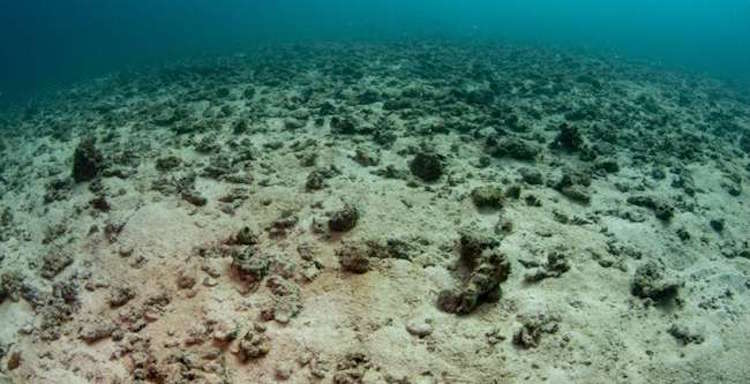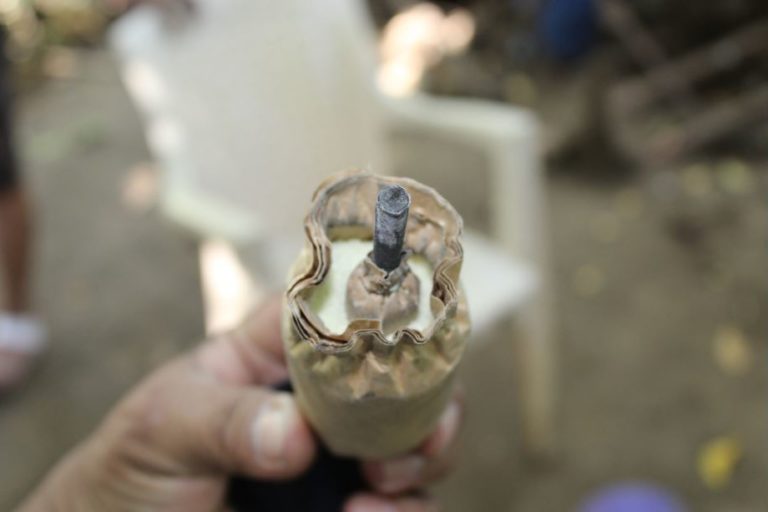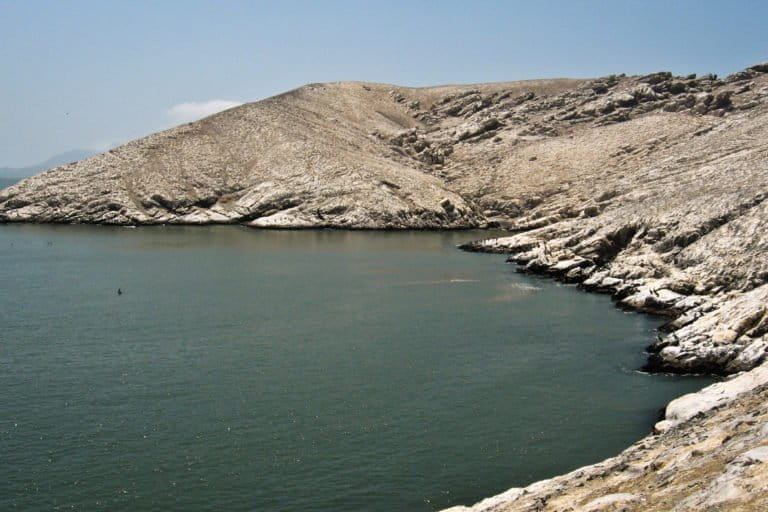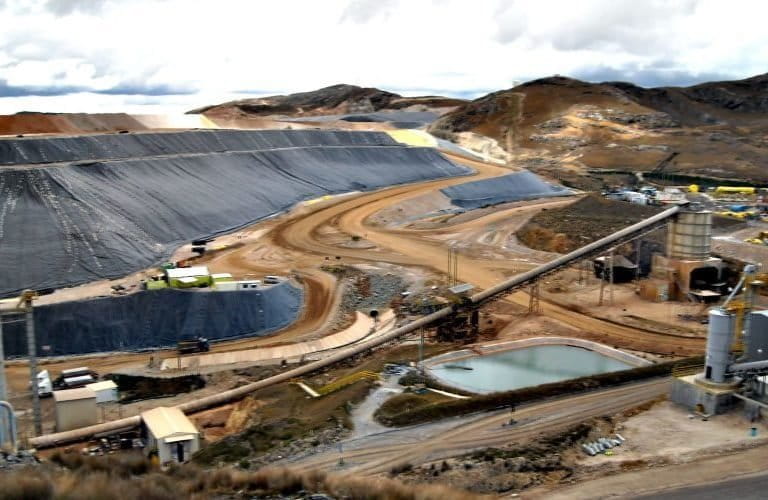- Peruvian authorities have noted an increase in fishing with explosives, one of the most devastating methods of harvesting fish.
- Traditional fishers and blast fishers have come into heated conflict over marine resources, leading to altercations and even death threats.
- Amid insufficient and allegedly corrupt law enforcement, fishers in the port city of Chimbote have begun patrolling local beaches themselves to defend them against blast fishers.
Nighttime falls on the fishing port of Chimbote, a city on Peru’s Pacific coast in Huarmey province. Almensor Gómez, an artisanal fisherman, prepares to leave home with five fellow fishers. But they aren’t going fishing. Instead, the group will stand guard tonight against poachers who use bombs to fish.
Armed with handguns, shotguns “and who knows what else,” says Gómez, their adversaries, “who are not so much fishermen as they are criminals,” set off explosions in the ocean to collect fish. “We have never had deaths, but we’ve had injuries,” says Gómez, who no longer complains to the captain of the port “because it does not help.” Once, one of his friends received a death threat upon arriving home, he says.
Fishing with bombs, or blast fishing, is considered one of the most devastating methods of fish collection. It is prevalent elsewhere in Peru and in several other countries in Latin America and beyond. Some records say the practice began in the Philippines, where fishermen used dynamite left over from the two world wars. However, there is evidence that it was practiced in Peru even earlier. Robert Cooker, a U.S. aquaculturist, discussed the practice in reports on a study he conducted for the Peruvian government between 1908 and 1910. Today in Peru, “the extensive mining activity makes access to dynamite relatively easy,” said Juan Carlos Sueiro, the fisheries director for the Peruvian branch of the international NGO Oceana.

Regardless of where blast fishing was invented, Gómez knows it causes a lifetime of struggle. He is the president of the Federation of Artisanal Fishermen of Ancash, the department that contains Huarmey province. Along with his colleagues, Gómez says he constantly tries to defend his source of work “with rocks or with whatever we have.”
“Yesterday, at 11 o’clock at night, these criminals came and we were able to chase them away, but they used dynamite on a place farther away,” he says. “The beaches are being left deserted. The resources are wiped out.”
Killing without destroying
Depending on the size and location of the fish, the bombs are made with different types and amounts of gunpowder. “The amount is calculated to not destroy the fish, so that after collecting them, they can be sold,” according to a 2015 report by the Marine Institute of Peru (IMARPE). The report says that “in the last few years, an increase in fishing with explosives has been reported on different beaches and islands along the coast.” Francisco Ganoza, the report’s main author and director of an IMARPE lab in the city of Huacho on the central Peruvian coast, told Mongabay Latam that the situation remains the same today.
“Underwater explosions release a large amount of energy in a short period of time, generating shock waves characterized by instantaneous high-pressure sound waves, which later decrease to negative amounts of pressure,” the report says. The rapid fluctuation between high- and low-pressure waves damages the internal organs of the fish, for instance rupturing their blood vessels or swim bladders, which function to adjust their buoyancy. The fish closest to the detonation end up too mutilated to sell.
The explosions also cause physical damage to the marine environment and to all the species living in the fishing area, like marine mammals, turtles and birds, as well as fish eggs and larvae, the report says. According to the nautical website Fondear, “an underwater explosion in a coral reef will necessitate between five and 10 years for the coral’s recovery, but a repeated bombardment, which is frequently the case, causes the definite destruction of the underwater habitat.” It is estimated that half the destruction of coral reefs in Southeast Asia is due to the use of explosives. The explosions can also kill or mutilate the blast fishers themselves.

Sueiro tells Mongabay Latam that the bombs are also used to flush fish so they can be captured. “The bonito [family Scombridae], for example, swims at depths that the nets do not reach. So the poachers set the dynamite, with a determined weight, so that it explodes low enough that the bonito reacts by rising in the water column and they can catch it,” Sueiro says.
In Huarmey, which is about 282 kilometers (175 miles) north of Lima, the technique involves opening dynamite cartridges and pouring the gunpowder into a nylon bag with a stone inside, forming a ball. The detonator, usually made of aluminum, bronze or copper, is placed inside the ball. Its function is to connect the fuse to the dynamite. The handlers allow a centimeter of the detonator to stick out the side of the ball, where they then install the fuse, surrounded by two matches to make sure it ignites. Finally, the bomb is wrapped in waterproof material like asphalt or plastic and is ready to detonate underwater.

The areas that are bombed are typically near the coast in rugged, rocky places, or around islands. Sueiro says he has noticed that fishermen also detonate bombs in places where there are no river mouths nearby. He believes this is because the rivers deposit sediment onto the ocean floor, causing the depth to decrease, and “what these people are looking for are wide water columns where there is a greater presence of species that swim in schools.” According to the IMARPE report, the poachers use a diver to find fish. One of the poachers then throws bombs, four to six of them, from a distance of about 4 or 5 meters (13 to 16 feet) away, “depending on the mobility and characteristics of the fish shoal.”
According to Sueiro, blast fishers target Peruvian weakfish (Cynoscion analis), Peruvian rock seabass (Paralabrax humeralis), common sole (Solea solea), and jack mackerel (Trachurus murphyi). But their favorite fish is the Peruvian grunt (Anisotremus scapularis). That’s bad luck for Gómez and the rest of the artisanal fishermen in Huarmey, because the grunt is also their preferred species.
An unpunished crime
According to data from IMARPE, the areas most frequently fished with bombs are the provinces of Huarmey, Pisco (including the National Reserve of Paracas), and Lambayeque, in addition to the city of San Juan de Marcona and the region of La Libertad.
Every year, an estimated 43,000 to 108,000 kilograms (95,000 to 238,000 pounds) of fish are killed using explosives in Huarmey alone. In Pisco, the estimates are between 32,000 and 65,000 kg (71,000 and 143,000 lb).

The fish caught using bombs are sold wholesale, destined mainly for large markets and restaurants in Lima. By contrast, artisanal fishermen like Gómez mostly sell to local markets, although their larger fish are sometimes traded and taken to Lima. “We are creating small businesses, in terms of the vendors of our artisanal fish, which can get into the big markets, but our sales are pretty local,” Gómez says.
He adds that the competition between artisanal fishermen and poachers is over resources. “We are shore fishermen, and that is where they throw bombs. Even right in front of us,” he says.
Although Gómez and his colleagues witness this illegal activity almost daily, they no longer report it. Instead, they organize themselves along the coast to try to defend the fish and drive the poachers away at dawn, during the daytime, and at night.

Peru’s Ministry of Production issued a statement saying that during 2017, “there were more than 104,000 inspections and 693 confiscations, which had a total weight of around 10,000 metric tons of illegally obtained hydrobiological resources.” The statement also said the ministry had conducted operations on beaches against illegal fishing. Additionally, the ministry held 148 training sessions encouraging responsible fishing and consumption that “benefited” around 6,000 people, including fishers and consumers.
However, ocean scientists and fishermen say these efforts appear to be insufficient. “According to general fishing laws, any activity that damages the ocean floor is prohibited,” says Renato Gozzer, a fishing specialist with the Peruvian NGO REDES Fisheries Sustainability. “However, the control measures, either preventive or punitive, are pretty weak. It’s a situation that gets little attention and little prioritization from the government, especially in coastal fisheries.”
IMARPE itself acknowledged in its report that “despite the increase in this activity [fishing with explosives], the number of interventions by police or authorities is practically zero.”

But the artisanal fishermen complain that the poachers are warned before each inspection and simply avoid fishing on those days. Gozzer, who has investigated illegal fishing activities, particularly in relation to the production of fishmeal, says these information leaks are due to corruption enabled by nebulous sharing of responsibilities between regional governments, the Ministry of Production and its departments of monitoring and control and vigilance, and the captains of the ports.
“Each entity has some power, but with limits, so they have to do coordinated operations that demand logistics. In those coordination efforts, the information can be leaked, and poachers learn that they should not go fishing,” Gozzer says.

According to Gozzer, other variables, such as the inspectors’ low salaries, the difficulty of monitoring rural areas and the lack of control mechanisms, all contribute to the corruption.
On the other hand, the IMARPE report says that “frequently, the DICAPI [General Directorate of Captaincies and Coastguards] of Pisco makes interventions and receives complaints or reports of fishing with explosives,. hHowever, if there is not enough information, the corresponding legal actions are not taken.” This was how Gómez’s colleague came to be threatened after reporting a group of poachers. “They caught them, but a while later they released them and they went to his house to threaten to kill him if he spoke out again,” Gómez says.
The illegal dynamite market
According to Sueiro, “the focus should be on the irregular sale and distribution of dynamite and not on the boats that are detonating bombs.”
The dynamite market in Peru is regulated by the National Superintendence of Control of Security Services, Weapons, Ammunition, and Explosives for Civilian Use (SUCAMEC) and relies on strict control measures. “We have had a period of very strong political violence, with terrorism and other issues. So, all the more reason that nobody should be allowed to sell dynamite anywhere without being authorized and having declared and demonstrated what they will use it for,” Sueiro says.
The dynamite used for fishing is generally stolen from mines and illegally sold to the fishermen through intermediaries. “The relative access and corruption make it easy to access dynamite, which is sold with total impunity. Very few cases receive judicial sanctions,” Sueiro says.

In Huarmey, the dynamite cartridges are sold by these intermediaries in the markets of Barranca and Las Malvinas. Typically, they originate from people who work in mines in the Lima and Ancash regions. Gómez remembers hearing four years ago that each cartridge cost $1.50 and each detonator cost $0.90.
In early 2018, the fishermen from Chimbote, with Gómez in the lead, began to have meetings with the Ministry of Production at which the fishermen agreed to monitor the vendors of the explosives, Gómez says. After Daniel Córdova, the minister of production, finished his term in April 2018, the meetings ended, Gómez says. “Although we already sent a document to continue with the process, nothing has happened,” he adds.
The 2015 report by IMARPE says “an indispensable requirement to combating and confronting fishing with explosives is the formalization of artisanal fishers.” According to Gozzer, “seven out of every 10 fishermen do not have permission to fish. Recently, there was an effort to formalize them, but it has not been made concrete.” IMARPE says says elsewhere that the registration of artisanal fishermen would “strengthen fishing communities and associations with the purpose of identifying the fishermen who work illegally.”
Fishermen and fishing experts appear pessimistic about the way Peruvian ocean resources are being managed. The country’s widely denounced neglect of its fishing sector has allowed extreme overexploitation to continue, even by methods as implausible as dynamiting the sea.
Banner image of a blast fisherman in Nicaragua, by Oscar Navarrete and Jorge Torres/La Prensa
This story was first published in Spanish on Mongabay Latam on Sept. 26, 2018.
